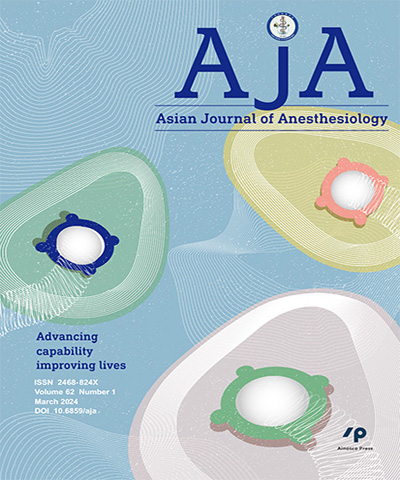
Asian Journal of Anesthesiology
- OpenAccess
- Ahead-of-Print
台灣麻醉醫學會 & Ainosco Press,正常發行
選擇卷期
- 期刊
- OpenAccess
Chronic post-surgical pain (CPSP) is a chronic pain condition, affecting many people who have undergone surgery. The development of CPSP is complex and the treatment options are limited; therefore, postsurgical pain management is crucial for satisfactory pain relief and prevention of CPSP development. In this review, we analyzed the existing treatment modalities for patients with CPSP. The treatments include opioids, acetaminophen, N-methyl-D-aspartate (NMDA) receptor antagonists, anticonvulsants, and local anesthesia. All treatments had significant effect on CPSP and opioid-sparing effect; moreover, preventive analgesic treatment is important for improving quality of postoperative pain management. However, since most of the studies had limitations, further research on determining effective combinations and treatment modalities is required.
- 期刊
- OpenAccess
Introduction: The impact of preoperative glycated haemoglobin (HbA1c) in patients undergoing gastrointestinal and hepatobiliary surgery is unclear as data is limited. Methods: Patients undergoing gastrointestinal surgery attending pre-assessment screening (PAS) clinics from August to September 2016 at the Queen Elizabeth Hospital Birmingham (QEHB) were identified. Outcome measure was postoperative complications as defined by the Clavien-Dindo classification system. Results: In this study, 381 patients were included, of which 48% (181/381) had HbA1c measured. Of these, 27% (49/181) had a HbA1c ≥ 48 mmol/mol. Overall complications were 14% and major complication rates were 3% (11/381). In unadjusted models, patients with HbA1c ≥ 48 mmol/mol had significantly higher rates of overall complications (odds ratio [OR] = 2.82, 95% confidence interval [CI] = 1.22-6.49; p = 0.015). In adjusted models, only surgical grade was predictive of overall complications. In patients undergoing major surgery (n = 93), there were significantly higher rates of overall complications in patients with HbA1c ≥ 48 mmol/mol as compared to those with HbA1c < 48 mmol/mol (63% vs. 46%, p = 0.043). Conclusion: Utility of HbA1c to stratify patients undergoing gastrointestinal and hepatobiliary surgery into high-risk clinics is limited from this study. Future studies should aim to validate these findings in much larger cohorts.
- 期刊
- OpenAccess
Objective: The aim of this meta-analysis is to verify the effectiveness of postoperative pain relief by perioperative parecoxib, a selective intravenous cyclooxygenase-2 (COX-2) inhibitor, for patients receiving laparoscopic cholecystectomy (LC) surgery. Methods: Electronic databases were searched for the randomized controlled trials (RCTs) to evaluate the effectiveness of pain relief by parecoxib or placebo for patients receiving LC surgery. The primary outcomes was the pain score evaluation using visual analogue scale (VAS). The secondary outcomes were the opioids consumption or analgesic supplement requirement and incidence of any adverse events such as dizziness, nausea and vomiting. Results: Ten trials with 916 patients were included. Perioperative parecoxib significantly reduced postoperative pain score with rest at post-anaesthesia care unit (PACU; mean difference [MD] = -0.58, 95% confidence interval [CI] = -1.04 to -0.12, p = 0.01) after LC. Postoperative opioid requirement or analgesic supplement for rescue of pain was also effectively reduced (relative risk [RR] = 0.47, 95% CI = 0.33 to 0.66, p < 0.0001). The incidence of side effects such as postoperative nausea and vomiting (PONV) was unaffected (RR = 0.83, 95% CI = 0.63 to 1.10, p = 0.20). Conclusion: Perioperative intravenous parecoxib could effectively provide pain relief and reduced postoperative morphine consumption or rescue analgesics for LC surgery without causing additional adverse concerns.
- 期刊
- OpenAccess
Objective: Supraglottic airway devices (SGAs) have advantages in reducing respiration-associated complications. However, limited studies on the influence of head and neck rotation on the risk of air leakage have been conducted. We hypothesize that different head and neck rotation angles will increase the risk of air leakage when using SGAs. Methods: A prospective, randomized study was conducted with 51 patients in the i-gel^(TM) group and 50 patients in the AuraOnce^(TM) group. The head and neck were subsequently rotated to the following positions: 0 (neutral), 15, 30, 45, and 60 degrees. Airway pressure over 20 cmH_2O was defined as negative for air leakage. Results: The percentage of air leakage was proportional to the increase in rotational degrees at the various rotation angles. The incidence of patients without air leakage at the largest angle (60 degrees) of head and neck rotation in both groups was approximately 80% (i-gel^(TM): 82.35%; AuraOnce^(TM): 79.59%). Conclusion: SGAs presented acceptable performance with increased head and neck rotation angles.

